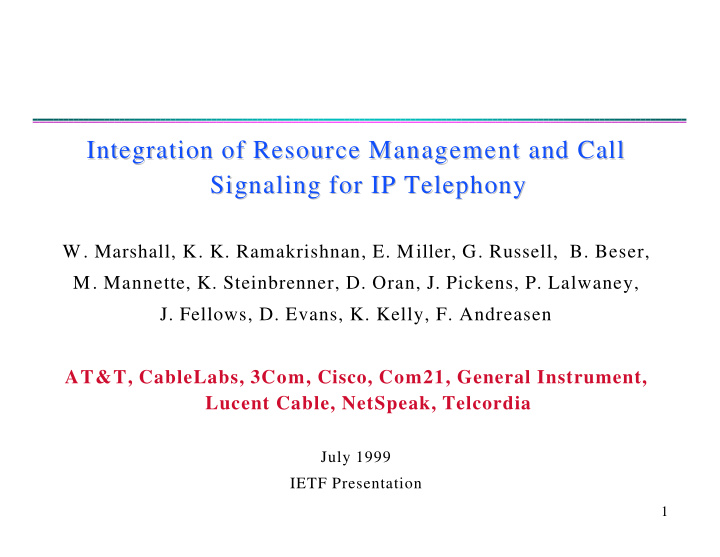



Integration of Resource Management and Call Integration of Resource Management and Call Signaling for IP Telephony Signaling for IP Telephony W. Marshall, K. K. Ramakrishnan, E. Miller, G. Russell, B. Beser, M. Mannette, K. Steinbrenner, D. Oran, J. Pickens, P. Lalwaney, J. Fellows, D. Evans, K. Kelly, F. Andreasen AT&T, CableLabs, 3Com, Cisco, Com21, General Instrument, Lucent Cable, NetSpeak, Telcordia July 1999 IETF Presentation 1
Call Setup: Call Setup: Fundamental Requirements Fundamental Requirements � First INVITE MUST go through proxies for authorization/translation � Resources must be available PRIOR to ringing far end phone � Service Quality Requirements must be met – 100ms post-pickup delay maximum » Terminating end-point’s Hello should not be clipped » Originating end-point’s Hello should not be clipped – Conclusion: 200-OK (pickup) MUST go direct, not via proxies 2
Critical Messages Critical Messages and their Relationships and their Relationships � MTA O ER O GC O GC T ER T MTA T INVITE (AI, E.164 T , CP O ) INVITE ($, CP O , E.164 T , CI O ) INVITE (GID T , E.164 T , CP O , [CI O ](GC T )) 200 OK ( IP T , CI T ) P I 200 OK ( T ) I P 200 OK (GID O , T , [CI T ](GC O )) Resource Reservation Starts ringback INVITE (RING) 180 RINGING 200 OK Call In Progress 3
Single-stage Alternatives Examined Single-stage Alternatives Examined � Allocate resources in access prior to single traditional INVITE – RSVP? But don’t know destination IP address of request – New protocol needed to do this � Allocate resources after INVITE, before Ringing phone – E.g., Destination send 100 Trying in response to INVITE » 100 Trying (via GC) must include SDP » Caller does an end-end RSVP, Dest request RESV-ACK » Callee also does and end-end RSVP exchange » On RESV-ACK + RESV, send 180 Ringing (via proxies) – 200 OK on pickup routed via Proxies » meanwhile, voice from destination is cut-through and may arrive at origin before 200 OK. User response is “clipped” 4
Conclusion: Need for Two-Stage INVITE Conclusion: Need for Two-Stage INVITE � First Stage - INVITE but do not alert receiving customer – Sent via proxies to perform authorization, translation, etc. – Acknowledgement via proxies, with Contact: header – Call features invoked with first INVITE, e.g. Call Forwarding, etc. � Second Stage - INVITE with alerting – Sent direct end-to-end – Interim and Final responses sent direct, low-latency path � Tradeoff between post-pickup delay and No-Answer handling – Call Forwarding No Answer becomes a transfer operation » Use call-control services, Replace: and Also: headers » Assistance from proxies likely 5
SIP Support needed for SIP Support needed for Resource Management Resource Management � Additional header in initial INVITE message – No-Ring = “NoRing” “:” 6
Recommend
More recommend